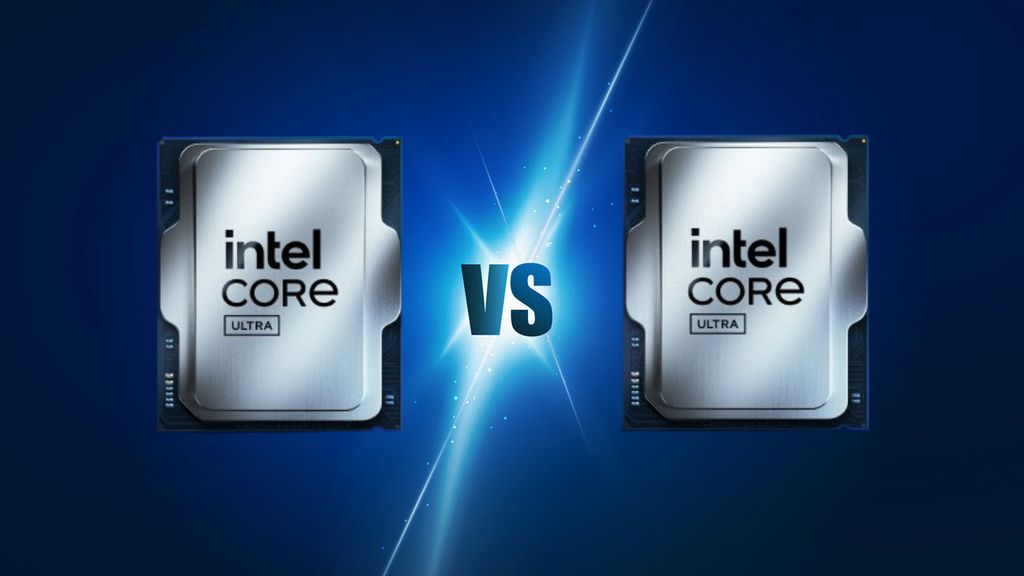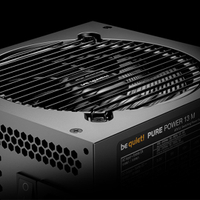
(Image credit: Shutterstock, Intel)
At first glance, pitting the Intel Core Ultra 7 265K vs Core Ultra 9 285 might seem like a foregone conclusion. After all, the $580 Core 9 285K carries a significantly higher price tag and is positioned as Intel’s top-tier offering in the Arrow Lake lineup, while the $290 Core 7 265K sits a rung below with a more modest price tag.
It’s easy to assume the more expensive CPU will simply outperform across the board. However, this comparison goes beyond raw performance numbers and pricing alone. With Intel recently slashing the 265K’s price by a substantial $100, the value proposition has shifted dramatically, raising important questions about which CPU truly makes more sense for different types of users and workloads.
Intel positions the Core Ultra 9 285K as its undisputed desktop champion, the apex predator designed for those who demand absolute, uncompromised performance. Sitting just below it, the Core Ultra 7 265K represents the savvy enthusiast's choice - a processor packing a massive amount of cutting-edge technology and core muscle, often delivering near-flagship experience, but crucially, now at a dramatically reduced price point.
We put these two Arrow Lake chips through a six-round gauntlet to determine if the 265K can hold its own, or if the 285K’s premium status truly justifies its cost.

be quiet! Pure Power 13 M 850W Power Supply: A PC doesn’t work properly without the right power supply. The Pure Power 13 M provides the PURE power you need. A certified 80+ Gold and Gold Cybernetics unit provides quiet and efficient power. It's ATX 3.1, making it compatible with the latest components, and with a semi-passive fan, it makes for an extremely quiet PSU.
Features and Specifications: Intel Core Ultra 7 265K vs Intel Core Ultra 9 285K
CPU | Street (MSRP) | Arch | Cores / Threads (P+E) | P-Core Base / Boost Clock (GHz) | E-Core Base / Boost Clock (GHz) | Cache (L2/L3) | TDP / PBP or MTP | Memory |
|---|---|---|---|---|---|---|---|---|
Core Ultra 9 285K | $589 | Arrow Lake | 24 / 24 (8+16) | 3.7 / 5.7 | 3.2 / 4.6 | 76MB (40+36) | 125W / 250W | DDR5-6400 |
Core Ultra 7 265K / KF | $394 / $379 | Arrow Lake | 20 / 20 (8+12 | 3.9 / 5.5 | 3.3 / 4.6 | 66MB (36+30) | 125W / 250W | DDR5-6400 |
The Intel Core Ultra 9 285K and Core Ultra 7 265K both belong to Intel’s latest Arrow Lake-S desktop processor family, with the compute cores built on TSMC's N3B (3nm) fabrication process. Architecturally, they share the same underlying hybrid core design featuring a combination of high-performance “Lion Cove” P-cores and efficient “Skymont” E-cores, as well as identical support for DDR5-6400 CUDIMM memory (DDR5-5600 for standard UDIMMs) and PCIe 5.0 connectivity.
Both processors use the new FCLGA1851 socket and are compatible with the same 800-series chipset motherboards. This common foundation means they benefit from the same modern features, such as unlocked multipliers for overclocking and integrated Intel Arc-Xe graphics with 64 execution units.
The primary difference lies in their core counts and thread configurations. The Core Ultra 9 285K boasts a total of 24 cores with 8 P-cores and 16 E-cores, yielding 24 threads. Meanwhile, the 265K offers 20 cores with 8 P-cores and 12 E-cores, totaling 20 threads. This difference in efficiency cores gives the 285K an advantage in heavily threaded workloads and multitasking scenarios.
The processors have different base and boost clock speeds, with the 285K running at 3.7 GHz base and 5.7 GHz boost on P-cores, and the 265K with a slightly higher 3.9 GHz base but a lower 5.4 GHz boost. The E-cores on both chips have a 4.6 GHz boost.
Cache sizes are also different between these two models. The 285K comes equipped with a larger shared L3 cache of 36 MB compared to the 30 MB on the 265K. This expanded cache on the 285K supports better data throughput and reduced latency, which can enhance performance in cache-sensitive applications such as gaming and content creation.
In terms of power consumption, both processors have a base TDP of 125 watts and a maximum turbo power rating of 250 watts, indicating similar thermal and power envelopes despite the 285K’s higher core count. However, the 285K, being the flagship CPU that it is, also has a PL2 “Extreme” power rating of 295 watts that can be accessed under certain conditions. Of course, this difference directly translates to thermal output and cooling concerns as well.
Looking at the spec sheet alone, the Core Ultra 9 285K offers a more robust core and cache configuration aimed at users demanding maximum multi-threaded performance, while the Core Ultra 7 265K provides a slightly higher base clock and an identical number of performance cores. Both processors have modern features and efficient power management, but the 285K targets enthusiasts and professional workloads that can leverage its additional cores and cache.
⭐ Winner: Intel Core Ultra 9 285K
Intel’s flagship wins out quite cleanly in this round due to its superior core counts, boost clocks, and larger L3 cache capacity.
Gaming Benchmarks and Performance: Intel Core Ultra 7 265K vs Intel Core Ultra 9 285K
While our in-depth reviews provide a more comprehensive analysis, this section will focus on a gaming performance overview. The benchmark graphs display average FPS and 1% lows for various games at 1080p, designed to maximize the observable difference between these CPUs. Using a high-end Nvidia GeForce RTX 5090 ensures GPU limitations are removed, making this setup ideal for comparing pure CPU performance.
According to our benchmark results, the Core Ultra 7 265K and Core Ultra 9 285K exhibit a consistent but relatively narrow performance gap across gaming benchmarks at 1080p. In the 16-game geomean using High/Ultra settings, the 285K delivers an average FPS of 144.9, compared to the 265K's 138.8 FPS - a difference of approximately a mere 4.4%.
The gap in 1% low performance is similarly modest, with the 285K achieving 107 FPS against the 265K's 103 FPS (a 4% advantage). This indicates that while the 285K is consistently faster, the uplift is marginal and stems primarily from its higher power budget and potentially slightly elevated clock speeds within the same core architecture.
Drilling into specific titles reveals further nuances. In Baldur's Gate 3, the 285K averages a 5% lead against the 265K, leveraging its clock speed edge in this single-threaded-heavy RPG. Cyberpunk 2077 showed a more modest gap, with the 285K coming out 2.7% ahead of the 265K, reflecting its superior multi-threaded performance in this CPU-intensive open-world title, driven by more E-cores and higher clocks handling AI and physics.
Additionally, in Minecraft RT, the difference was minimal. The 3.8% average and 3.4% lead in 1% low numbers suggest ray tracing’s mixed CPU-GPU demands lessen the 285K’s edge, with its extra resources offering marginal gains in geometry processing.
The difference in 1% low performance is arguably more critical for perceived smoothness than average FPS. Across the tested suite, the 285K consistently delivers slightly higher minimums, as seen in the 16-game Geomean gap of 4%. However, the difference is not as substantial as one would expect. As an example, in Watch Dogs Legion, the 285K's 1% low numbers only showed a modest 6% advantage over the 265K.
Efficiency heavily favors the Core Ultra 7 265K. The 16-game Efficiency Geomean (FPS per Watt) shows the 265K at 1.50 FPS/W, significantly outperforming the 285K's 1.37 FPS/W. This 9.5% efficiency advantage is directly linked to power consumption.
The Power Geomean confirms the 265K draws an average of 92.8 Watts during gaming, while the 285K consumes 106 Watts – a 14.3% increase for its modest performance gain. The 265K delivers more frames per unit of power, making it the cooler and less demanding option during gaming.
The performance per dollar argument is decisively won by the 265K. Our 16-game Value Geomean places the 265K at 0.48 FPS per dollar, nearly double the 285K's score of 0.25. This stark difference highlights the law of diminishing returns at the high end. The 285K costs twice as much as the 265K but only delivers a 4% average performance increase. For strictly gaming, the 285K's price premium buys minimal extra frames, making the 265K the far more cost-effective choice.
Ultimately, the Core Ultra 9 285K offers a measurable, but consistently modest, gaming performance advantage over the Core Ultra 7 265K at 1080p, typically around 4-6% in averages and 1% lows across a broad suite of games. Its primary advantages manifest in slightly higher sustained performance in CPU-intensive titles. However, these gains come at significant costs: a 14% increase in power consumption (reducing efficiency by 9.5%) and, most critically, double the price, resulting in the 265K offering nearly twice the value.
⭐ Winner: Tie
For gamers prioritizing price-to-performance and efficiency, the Core Ultra 7 265K is a compelling choice. The 285K's minor performance uplift is only justifiable if budget is not a constraint and every last frame is critical, but it represents a steep premium for limited gaming gains over its sibling. For this round, though, we are not looking at value and just looking at raw performance numbers, in which the Core Ultra 9 285K comes out on top.
Productivity Performance: Intel Core Ultra 7 265K vs Intel Core Ultra 9 285K
(Benchmark charts)
Our thoroughly tested benchmark data reveals a clear and consistent performance hierarchy between the Core Ultra 9 285K and the Core Ultra 7 265K in productivity workloads, with the 285K holding a significant, though workload-dependent, advantage.
The most telling metric comes from the overall multi-threaded performance ranking (Geomean), where the results show a substantial 18.2% performance delta in favor of the flagship 285K across a suite of tests, including Cinebench, POV-Ray, V-Ray, Blender, and Handbrake, etc. This gap underscores the impact of the 285K's higher core/thread count and potentially enhanced binning.
In Cinebench 2024 Multi-Core, a cornerstone CPU rendering test, the 285K achieves a substantial 15.9% lead over the 265K. The gap widens further in POV-Ray Multi-Core, a pure ray-tracing workload, where the 285K dominates the 265K by a notable 14.0%.
Even in Handbrake x265 10-bit encoding, a real-world video processing task, the 285K maintains its lead with an 11.4% advantage. This consistency across diverse rendering and encoding tasks confirms the 285K's superior capability for heavily parallelized productivity applications.
While the 285K's multi-threaded dominance is clear, the gap narrows considerably in single-threaded performance, which is crucial for many everyday productivity tasks and applications with limited threading. Our overall single-threaded performance ranking (Geomean) places the 285K at 276 points and the 265K at 270 points, a much smaller but still meaningful 2.2% difference.
This tighter margin is reflected in component tests: the 285K scores an advantage of 4.1% vs the 265K in Cinebench 2024 Single-Core, and completes the LAME MP3 encoding task nearly 1% faster than the competition. This indicates that for lighter, less parallel tasks, the performance difference between the two chips becomes less pronounced, though the 285K consistently holds a slight edge.
The performance delta also manifests in modern web-based productivity. The WebXPRT 4 benchmark, simulating HTML5 and JavaScript workloads common in web apps, shows the 285K taking a 3.5% lead over the 265K. While smaller than the gaps seen in pure rendering/encoding, this difference can still translate to perceptibly snappier performance in complex web applications and services, reinforcing the 285K's overall productivity advantage across a broader spectrum of tasks.
As expected, the Core Ultra 9 285K establishes a definitive lead over the Core Ultra 7 265K in productivity performance, particularly in heavily multi-threaded scenarios like rendering and encoding, where its advantage ranges from 11% to 18%. This lead narrows to 2-4% in single-threaded and lighter workloads, but the 285K consistently maintains the top position. The 265K, however, counters with exceptional value, delivering performance that often surpasses previous-generation high-end chips at half the price of the 285K.
⭐ Winner: Intel Core Ultra 9 285K
It comes as no surprise that the flagship Core Ultra 9 285K takes this round simply because of its higher core and thread count. However, the competition was not as one-sided as it initially seemed to be.
Overclocking: Intel Core Ultra 7 265K vs Intel Core Ultra 9 285K
Both the Intel Core Ultra 7 265K and Core Ultra 9 285K share the same underlying Arrow Lake architecture, which means they possess identical overclocking features and capabilities. However, the 285K offers slightly better overclocking potential due to its higher base specifications and additional cores.
It also benefits from higher quality silicon binning, meaning Intel selects the most efficient and robust chips for this tier. This typically translates to an inherently higher tolerance for elevated voltages and temperatures under load, providing more thermal and electrical headroom for enthusiasts to exploit.
Both processors utilize Intel's advanced Arrow Lake overclocking features, including unlocked multipliers, DLVR (Digital Linear Voltage Regulator) support, and per-core voltage control. Intel has also increased the thermal limit to 105°C for better overclocking headroom compared to previous generations. Enthusiasts will find the essential BIOS/UEFI settings required for pushing performance boundaries readily available for both CPUs on compatible Z-series motherboards.
The overclocking experience is remarkably similar between both processors, with minimal headroom for P-cores but significant potential for E-core overclocking. Both CPUs can achieve P-core frequencies around 5.5-5.7 GHz and E-core frequencies up to 4.7-5.0 GHz under proper cooling conditions.
For overclocking enthusiasts, the Core Ultra 9 285K is the slightly superior choice despite its higher price point. The 285K's higher base power limits and better binning make it more suitable for sustained overclocking sessions. However, the 265K remains an excellent overclocking platform that offers nearly identical capabilities at a lower cost. Its lower peak power draw and thermal output leave relatively more room for overclocking experiments.
⭐ Winner: Tie
Although there are some differences in the overclocking experience of the two processors, their benefits and drawbacks ultimately cancel each other out, leading to a stalemate in this round.
Power Consumption, Efficiency, and Cooling: Intel Core Ultra 7 265K vs Intel Core Ultra 9 285K
Based on our thorough testing results, Intel's Core Ultra 7 265K and Core Ultra 9 285K exhibit significant differences in power behavior, impacting both efficiency and cooling requirements.
(graphs here)
At idle, the 265K demonstrates a clear advantage. During full system idle, the 265K consumes exactly half as much power as the 285K, according to our benchmarks. This gap persists in active idle scenarios like YouTube playback, where the 265K exhibits a substantial 22% power draw advantage over its older brother. This suggests the 265K's power gating is more refined for low-load states, offering tangible energy savings for routine desktop use.
Under sustained heavy loads, the 285K's higher performance ceiling comes with substantial power costs. In Prime95 Small FFTs test with AVX, the 285K consumes, on average, 5% more power than the 265K.
The disparity widens in real-world workloads: during HandBrake x265 encoding, the 285K consumes 27% more power than its younger sibling, which is exactly the same difference that we found in the Cinebench 2024 Multi-core test. This consistently higher power draw under load is likely due to the 285K's aggressive boosting to leverage its additional cores and higher clocks.
The efficiency analysis reveals even more points in favor of the 265K. In HandBrake, the 265K is markedly superior, achieving a 13.8% higher efficiency in our tests, meaning the 265K delivers more performance for each watt consumed in this task. However, Cinebench 2024 efficiency test shows near parity, with both CPUs being quite close to each other in terms of efficiency.
This indicates that while the 285K consumes significantly more absolute power in Cinebench, its higher raw performance output may balance efficiency for this specific benchmark. The 285K's efficiency is more workload-dependent, while the 265K shows greater consistency.
Cooling demands correlate directly with power consumption, as higher wattage generates more heat. The 285K's higher sustained power consumption (peaking near 325W-330W in AVX loads) translates directly into greater heat output. This necessitates a substantially more robust cooling solution (high-end air cooler or 280mm+ AiO liquid cooler) compared to the 265K, which peaks around 310W-315W.
While 15-50W might seem marginal, it represents a significant thermal density increase, pushing cooling systems harder and potentially increasing noise levels under full load. The 265K will be demonstrably easier and cheaper to cool effectively, and you can get away with a robust air cooler or a 240mm AiO liquid cooler.
Looking at the evidence, the Core Ultra 7 265K emerges as the more power-efficient processor overall. Its significantly lower idle consumption and consistently lower load power in most benchmarks make it the better choice for energy-conscious users or quieter systems. While the 285K matches its efficiency in some benchmarks, its higher absolute power draw makes it substantially harder and more expensive to cool effectively under sustained heavy workloads.
⭐ Winner: Intel Core Ultra 7 265K
If outright peak performance is the absolute priority, the 285K delivers it, but at a significant cost in power and thermal headroom. For a balance of strong performance, superior efficiency, and easier cooling, the 265K holds a clear advantage in this round.
Pricing: Intel Core Ultra 7 265K vs Intel Core Ultra 9 285K
Intel's recent $100 price cut on the Core Ultra 7 265K, bringing it down to an MSRP of $290 (we see current retail pricing between $280 and $295), dramatically reshapes the value proposition against the flagship Core Ultra 9 285K at an MSRP of $580 ($560 to $620 at retail ). Analyzing just the CPU cost tells only part of the story; the true impact lies in the total platform investment required to unleash these processors' potential, especially for enthusiasts.
Both CPUs require the same LGA 1851 socket, meaning motherboard costs (Z790 or future Z890 chipset) are largely comparable. Similarly, DDR5 memory costs are identical regardless of which CPU is chosen. The critical divergence comes with power delivery and cooling demands.
The Core Ultra 9 285K's significantly higher base and boost power targets necessitate a more robust power delivery subsystem (VRM) on the motherboard and a substantially more powerful cooling solution. While a capable mid-range air cooler or 240mm AIO might suffice for a moderately overclocked 265K, taming a heavily overclocked 285K almost universally demands a premium motherboard with top-tier VRMs and a high-end 280mm or 360mm AIO or exotic cooling, adding potentially $100-$200+ to the platform cost compared to the 265K setup.
The Core Ultra 7 265K offers significantly better value for the vast majority of enthusiasts. The $290 price tag post-cut is exceptionally compelling. The price difference (also $290) at the CPU level translates to an even larger effective gap when factoring in the savings on cooling and potentially a slightly less extreme motherboard requirement.
These massive savings can be redirected towards a substantially better GPU, more/faster storage, or simply a lower total system cost. While the Ultra 9 285K delivers ultimate multi-core performance, its price premium is steep, and the platform cost amplification erodes its value proposition severely. The 265K provides near-flagship gaming performance and robust multi-core capability at a platform cost that feels genuinely balanced.
For enthusiasts prioritizing maximizing performance-per-dollar across their entire system build, the Core Ultra 7 265K is the definitive value champion. The Ultra 9 285K remains a justifiable purchase only for those seeking absolute peak performance, regardless of cost, or for specific highly multi-threaded workloads where its extra cores provide tangible, revenue-generating benefits that offset the high platform expense.
⭐ Winner: Intel Core Ultra 7 265K
While the 285K offers additional efficiency cores and marginally better performance, the 100% price premium cannot be justified by the modest performance improvements. The 265K provides nearly identical gaming performance and excellent productivity capabilities at half the cost.
Bottom Line: Intel Core Ultra 7 265K vs Intel Core Ultra 9 285K
| Row 0 - Cell 0 | Intel Core Ultra 7 265K | Intel Core Ultra 9 285K |
Features and Specifications | Row 1 - Cell 1 | ❌ |
Gaming | ❌ | ❌ |
Productivity Applications | Row 3 - Cell 1 | ❌ |
Overclocking | ❌ | ❌ |
Power Consumption, Efficiency, and Cooling | ❌ | Row 5 - Cell 2 |
Pricing | ❌ | Row 6 - Cell 2 |
Total | 4 | 4 |
With a final score of 4-4, we're technically left with a dead heat, but the real decision boils down to your budget and use case.
The Intel Core Ultra 9 285K has a decisive win in raw specifications and productivity performance, underscoring its position as Intel's current desktop flagship. However, its gaming performance is uncomfortably close to the Core Ultra 7 265K, only winning by a mere 4.4% despite costing exactly twice as much as the 265K. When installed on a high-end platform with ample cooling, the 285K delivers the absolute peak performance available within this Intel generation, but due to the lackluster gaming performance relative to the much more affordable 265K, it has a hard time justifying its premium status.
The Core Ultra 7 265K delivers a powerful counterpunch where it matters most for many enthusiasts: real-world value and efficiency. Its convincing wins in the efficiency and pricing rounds (amplified by Intel's recent $100 cut) paint a compelling picture. This chip offers nearly the same gaming performance as the flagship at half the cost. The 265K offers a staggering amount of near-flagship performance, particularly potent in gaming and very strong in productivity, while demanding significantly less from your wallet, your motherboard's VRMs, and your cooling solution.
Ultimately, your choice boils down to priorities. If uncompromised peak performance is your sole objective and budget is secondary, the Core Ultra 9 285K is your champion. It delivers the highest frame rates, the fastest renders, and the most cores of any current-gen Intel CPU.
However, for the overwhelming majority of enthusiasts seeking exceptional high-end performance balanced with smart spending, thermal efficiency, and outstanding value, the Core Ultra 7 265K is the wiser, more compelling purchase. It gets you remarkably close to the flagship experience while freeing up substantial budget for other components that will provide a tangible benefit.
More CPU Faceoffs
- AMD Ryzen 9 9950X vs Intel Core i9-14900K
- Intel Core i5-14400 vs AMD Ryzen 5 7600X
- AMD Ryzen 7 7800X3D vs Intel Core i9-13900K vs Core i7-13700K
- AMD Ryzen 9 7950X3D vs Intel Core i9-13900K Faceoff

-
 C114 Communication Network
C114 Communication Network -
 Communication Home
Communication Home


